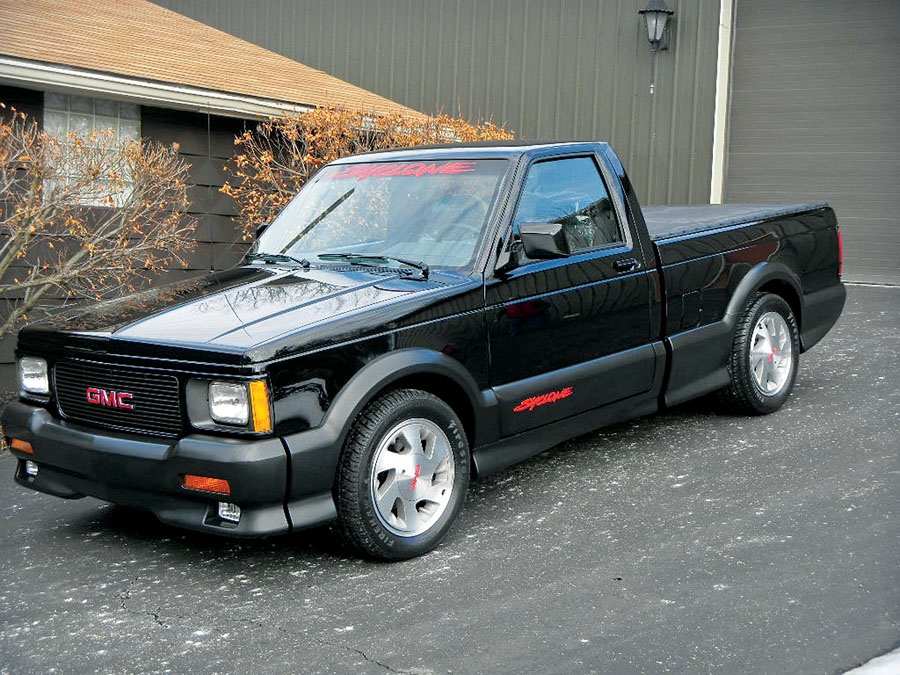SCM Analysis
Detailing
| Vehicle: | 1991 GMC Syclone Pickup |
| Years Produced: | 1991 |
| Number Produced: | 2,995 |
| Original List Price: | $25,790 |
| SCM Valuation: | $20,000–$35,000 |
| Tune Up Cost: | $150 |
| Distributor Caps: | $15 |
| Chassis Number Location: | Plate on the driver’s side instrument panel behind windshield |
| Engine Number Location: | Pad on the left rear side of engine |
| Website: | www.sportmachines.com |
| Alternatives: | 1990 Chevrolet 454 SS pickup, 1989 Shelby Dodge Dakota, 1993 Ford Lightning pickup |
| Investment Grade: | C |
This truck, Lot 228, sold for $35,200, including buyer’s premium, at Auction America’s Fort Lauderdale, FL, auction on March 27, 2015.
Think of it as a two-seat sports car with room — lots of room. No need to pack light for a weekend jaunt, no need to buy just one bag of groceries. The GMC Syclone was the solution to the age-old problem of postage-stamp trunk space in two-seater sports cars. “But it’s a pickup truck,” you say. No more than a Ferrari FF is a 2-door station wagon.
Putting sport in a truck
These trucks were conceived by Buick engineers, who were looking for a project to utilize their knowledge of turbocharging after the end of the Grand National/GNX program.
In 1989, those engineers helped Pontiac create the limited-edition Firebird Turbo Trans Am to celebrate the 20th anniversary of the Firebird’s flagship model. Using the 3.8L turbo V6 from the Grand National, Pontiac contracted with Prototype Automotive Services to build the Turbo Trans Am in PAS’s City of Industry, CA, facility.
After that program, those same gearhead engineers started playing with a turbocharged Chevy S10 pickup. They took a black truck, added “Grand National Intercooled” badges and Grand National wheels, and put “Buick” on the tailgate. Buick wasn’t interested in building the truck. Chevrolet wasn’t either, as they already had their full-sized 454 SS pickup in production. But GMC truck wanted to spice up their practical, utilitarian image, and the Syclone was born.
A Porsche with a bed
“Think of it as a Porsche 911 that really ‘hauls.’” said the full-page ad in USA Today. To prove its point, GMC listed the specs of the new Syclone next to that of the Porsche 911 Carrera 4.
What GMC had done, in true muscle-car fashion, was raid the GM parts bins to build more that just a powerful compact truck. Full-time all-wheel drive came from the Chevy Astro van, which shared the same chassis as the S-10/Sonoma, delivering the power 35% front/65% rear. And what power! The Buick 3.8L turbo wouldn’t fit the truck’s engine compartment without significant work, but the GM 4.3L Vortec V6 fit just fine. Those power-mad engineers added a Mitsubishi TD06-17G turbo, a water-to-air intercooler, and a modified 48-mm Corvette throttle body. The result was 280 hp and 350 lb-ft of torque in the 3,500-pound pickup.
“The Syclone will beat a brand-new $122,000 Ferrari 348ts,” wrote Car and Driver magazine in one of its infamous apples-to-oranges road tests. “No doubt about it. If the script is right. Be careful of heat though, because temperatures above, say, 75 degrees, cause significant power losses. On cool days, the Syclone’s turbo, torque converter, and adhesive-tape traction are devastating from 0 to 60. Above 80 mph, it pays for its truck shape. It clears the quarter-mile in 14.1 seconds, compared with 14.5 seconds for the Ferrari, but the Ferrari is moving 6 mph faster (99 mph versus 93). The Ferrari grabs the lead very soon after the quarter and never looks back. Its top speed is 166 mph. The Syclone’s is 126.”
Usable power
The ridiculous speeds that the magazine’s testers saw could be obtained not only in perfect weather, but in the wet too, thanks to the AWD. Keeping everything planted were 245/50/16 Firestone Firehawk tires on 16×8 alloy wheels unique to the Syclone. Brakes were discs front, drums rear, but the Syclone was the first truck equipped with four-wheel anti-lock brakes. The hunkered-down suspension was stiffened with heavier springs and sway bars.
The only transmission available was the 700R4 automatic, also from the Corvette. Car and Driver continued: “It also happens to be pretty darn good at the other moves we Americans expect of sports cars. It beats the Ferrari at braking, too, drawing to a stop from 70 mph in 183 feet, four feet shorter. Cornering grip is less but, at 0.80 g, it is still respectable. If results count more than labels, the GMC Syclone is truly a sports car too that will have to be reckoned with.”
GMC sold 2,995 of the $26,000 Syclones in 1991, including 113 export “Saudi” trucks, but canceled it after the first year. PAS built the similar Jimmy-based GMC Typhoon SUV in 1992–93, and sold almost 2,000 more. That’s the enigma of the Syclone — it was a great sports car but couldn’t haul a trailer or much of a payload (500 pounds max). That made it a very expensive big boy toy (at least the $30,000 Typhoon had room for five and inside storage). That hurt sales when it was new, and doesn’t help value today.
The good news is the Syclone seems to be past the bottom of its value curve and starting to climb. And with just 1,795.9 miles on the odometer, this Syclone is about as well preserved as you can find. Both factors probably pushed this sale higher than any Syclone we’ve seen. I would rather have purchased Apple stock back in the ’90s, but at least the Syclone is starting to be seen for what it is, and pay back a dividend. This one was very well sold, at least for now.
(Introductory description courtesy of Auctions America.

Pingback: 10 Reasons To Consider Buying A Used GMC Syclone Today - yorkclassiccars.com